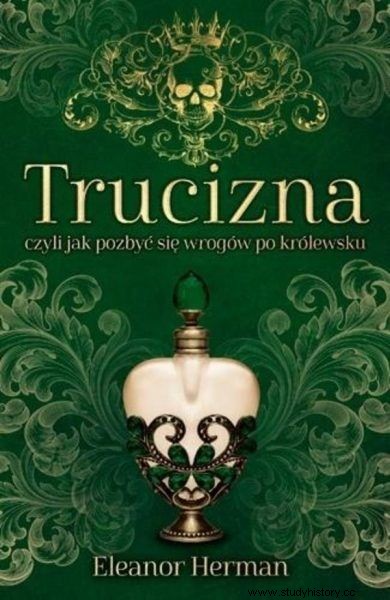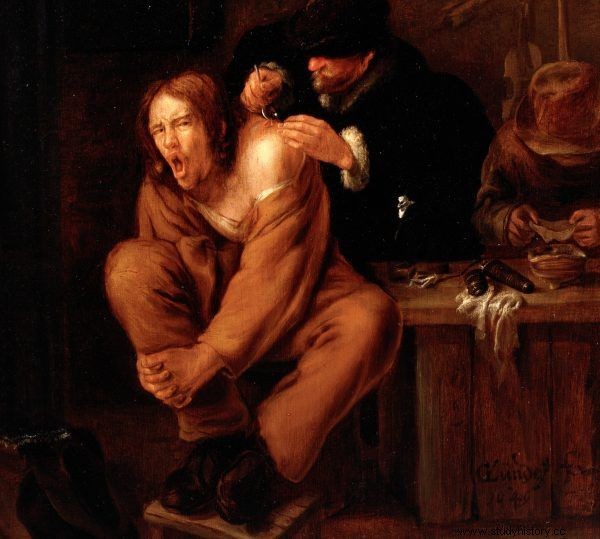In the past, doctors did not care about ethics and when they came up with the idea of a new therapy, they eagerly put it into practice. They cannot be denied fantasy. Patients were prescribed poop ointments, mercury inhalations and rubbing the dead man's finger. What else could be found in the first aid kit of our ancestors?
Nowadays, medical products are subject to strict tests that confirm their effectiveness and safety. And although sometimes patients mistakenly ask in pharmacies for nitroglycerin suppositories or cyanide ointment, it is really hard to hurt yourself by following the doctor's recommendations.
However, in the past, when medicine was not at such a high level, it was easy to find specificities more harmful than useful. Some potions turned out to be lethal…. Here are a handful of examples of the stupidest ideas doctors have for "healing" patients.
First aid kit full of heavy metals
Metals - especially those difficult to obtain or simply rare - have long been in the "target" of doctors. Lead and silver are indeed very useful in many areas of industry and jewelry, but they are definitely not medical agents.
Of course, the healers of the 16th century, such as Ambroise Paré, who recommended applying silver-bleached lead plates to ulcers on the skin, did not know this . Such a procedure could kill the bacteria, of course, but the metal particles getting into the bloodstream certainly did not help the unfortunate patient.

Ambroise Paré (pictured preparing to amputate a patient's leg) had many intriguing ideas about the "healing" properties of heavy metals and ... feces.
But Paré did not stop at rubbing the ulcers. His way of dealing with pathological bone changes caused by syphilis was to cut the muscles and rub mercury directly onto bone tumors. There is no need to describe the side effects of such therapy, not to mention the suffering it caused the patient ...
"Alchemy" remedies were generally very popular in the past. The father of modern medicine himself, Paracelsus, recommended applying arsenic ointment to the blemishes on the skin, and Alexius Pedemontana recommended mercury ointment for hemorrhoids. The latter, for a better impression, added rose oil and myrrh to the specifics.
Years later, at the beginning of the 18th century, arsenic was replaced with antimony - a substance that is no less hazardous to health. It was administered in the form of the so-called "perpetual pill" - a capsule made of a poisonous element, filled with mercury mixed with sugar and swallowed as a laxative. Worse still, this "cure" was used many times:after defecation, the antimony ball was "caught" and refilled with the killer mixture. There have even been cases of passing this bizarre and decidedly unhygienic "medicine" as part of the inheritance.
What doesn't kill you is you… nausea
The use of seemingly unlikely substances as part of treatment was common for many years. As late as the early 1900s, American medics used a mixture of strychnine and whiskey injected intravenously to speed up the heart. And they were not alone in this practice. Thomas Morris reports that:
European surgeons preferred Old World liquors:in the 1890s Charles Ballance gave a patient during surgery a mixture of brandy and brine that was so electrifying that at the end of the procedure the patient no longer seemed dead, but was so drunk and unruly that it took five peasants to keep him on the table .

There were also recommendations for hot coffee and whiskey enemas to help heal heart wounds, although their effectiveness was rather poor ...
But let's go back to the old days. In the Middle Ages and the Renaissance, many doctors used slightly less dangerous, but much more disgusting, ingredients in medicines. The pharmacies were full of all sorts of 'exhibits', and the lists of ointments and decoctions were endless - all to create an impression of mystery and mysticism.
Meanwhile, one of the recipes of Master Alexius who lived during the Renaissance was grated mouse droppings mixed with plantain juice and sugar. The preparation was supposed to help with "spitting blood". Even so, this "mouse" remedy seems quite digestible compared to other "creative" ideas that seem to be completely out of the question today.
For nosebleeds, Alexei recommended "tampons" made of pig excrement, tried to treat kidney stones and urinary bladder infections with cow dung (mixed with fruit juice, sugar and honey - for ease of swallowing), and as a remedy for all ailments, he used human stool powder ... blown into the eyes.

Therapies prescribed by former doctors were disgusting, painful and ... deadly.
Good for everything
Fecal lubrication seems to have been fashionable in ancient medicine. As we read in Eleanor Herman's book "Poison, or How to Get Rid of Your Enemies Kingly":"In the 1660s, Thomas Willis, the richest English doctor, recommended treating lung ailments with a drink made from horse, rooster, cow or pigeon droppings. The good doctor appreciated my chest with dog poop ointment and almond oil. ”
One thing must be admitted - Willis managed to create an effective laxative in the form of rat pellets which, when eaten, could cause a sudden bowel movement. However, it was not particularly salutary for the sick person. The patient's body was just trying to get rid of the harmful substances!
However, the aforementioned Ambrose Paré achieved the mastery in the art of disgusting treatment, combining his "beloved" mercury with feces. He recommended giving "live silver" (as liquid mercury was called) to the puppy as a laxative, and then collect his poop, boil it in vinegar and drink it. Many patients must have gotten diarrhea just thinking about the doctor on the way ...
Speaking of fear of the doctor, many of the therapies devised by former medics were more like torture than professional treatments, and incomparably more terrifying than visits to a modern dentist. So what were the patients at risk of?

Medieval and Renaissance pharmacies were filled with bizarre specialties. Some of them turned out to be deadly.
Doctor's torture chamber
Treatment methods that we would have no hesitation in considering torture today used to be commonplace in the past. In the days of Hippocrates, it was believed that a good method of getting rid of hemorrhoids was to pull them out with fingernails. But it's still nothing - Saint Fiakier advised those suffering from this unpleasant ailment burn the anus with a hot rod .
However, the list of inhuman medical practices in the past centuries is much longer. For example, one way to remove painful ulcers from syphilis sufferers during the epidemic of the disease in Europe was to burn them even more painfully with hot rods. Which of course did not have any positive effect - on the contrary, it often resulted in additional infections.
Doctors soon realized they had hit a dead end and returned to mercury, this time mixed with patina, cinnabar, rust, and turpentine, as well as powdered earthworms and lard. The ointments, however, did not always bring the desired effect, so more drastic therapy was used. The sick person was placed in a tent filled with vapors of hot mercury, arsenic, antimony and lead. The surgery resulted in tooth loss and damage to the throat, lungs and brain . Especially the latter ones were unfortunately irreversible.
The methods of treating mental illnesses - mainly schizophrenia - were also very drastic. From antiquity to the Middle Ages, skulls were trephined for "insane" people. However, in the 1950s, patients were deliberately put into insulin coma, which was associated with a high risk of complications, and even death.

They were also subjected to hot and cold "hydrotherapy" (consisting in forcibly keeping them in hot or ice-cold water). In turn, psychiatrist Henry Cotton theorized that schizophrenia is the result of prolonged organ inflammation, so he removed his patients' teeth, tonsils, and even fragments of the intestines. No wonder then that he failed to cure anyone this way.
A paradise for mystics and cannibals
A completely separate category in ancient medicine were drugs made from… human remains. As Eleanor Herman writes in the book "Poison, or how to get rid of enemies in a royal way":"From the court archives we learn that several monarchs - kings of England Charles II and William II, King of France Francis I and King of Denmark Christian IV - they were actually cannibals when it comes to medications . It is not known if Elizabeth I consumed the human body, but two of her favorite doctors were happy to recommend them to their other patients. "
Paracelsus claimed that after death (especially a tragic one - people who died of old age were not recommended), there was a "balm" in the human body, which had life-giving properties. That is why "medicines" were created from powdered elements of the dead. Probably the worst practice, however, was ... rubbing the hemorrhoids with a finger from the hand of the deceased.
Although no one has ever proven the healing effect of remedies from human remains, even pills made of powdered fragments of Egyptian mummies were popular for some time. However, they should be included in the group of "mystical" drugs that do not have any health effects - just like the notorious unicorn horns and mandrake roots.

The mandrake root extraction procedure was somewhat complicated.
The former actually came from the bones of various animals - including "sea unicorns" or narwhals, and the latter were collected according to very complex, almost impossible rules. As noted by Szymon Syreniusz, who lived at the turn of the 16th and 17th centuries, a rope should be tied to the mandrake leaves, the other end of which is attached to the tail of a black dog that has been starving for two days . The animal should be teased with meat on Friday, before sunset, until it pulls out the plant.
There is no need to comment on the rationality of such a procedure - it is another example of hiding the practical ignorance of pharmacists under the mantle of mysticism. Fancy dietary supplements and "left-handed" vitamin C work in a similar way today, with the difference that in the past it was easier to persuade people to eat dried earthworms.
Bibliography:
- E. Herman, Poison, or how to get rid of your enemies royally , Znak Horyzont, Krakow 2019.
- A. Kempiński, Schizophrenia. Wydawnictwo Literackie, Krakow 2009.
- T. Morris, Matters of the Heart:A History of the Heart in Eleven Operations, Wydawnictwo Literackie, Krakow 2019.
- A. T. Scull, Madhouse:a tragic tale of megalomania and modern medicine . New Haven:Yale University Press 2005.
- J. Thornwald, Ancient Medicine. Its mystery and power. Egypt, Babylonia, India, China, Mexico, Peru , Wydawnictwo Literackie, Krakow 2017.
